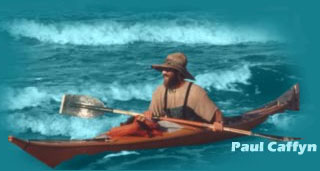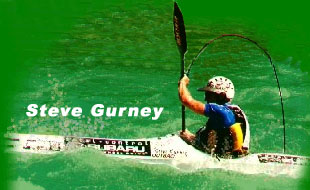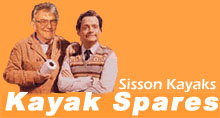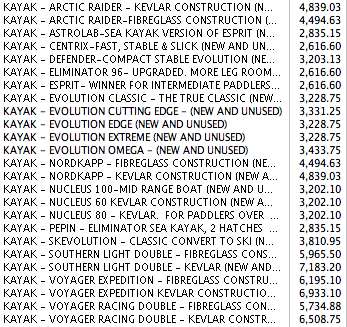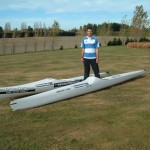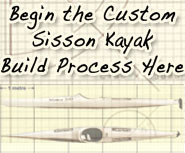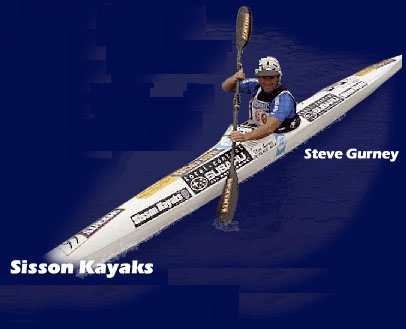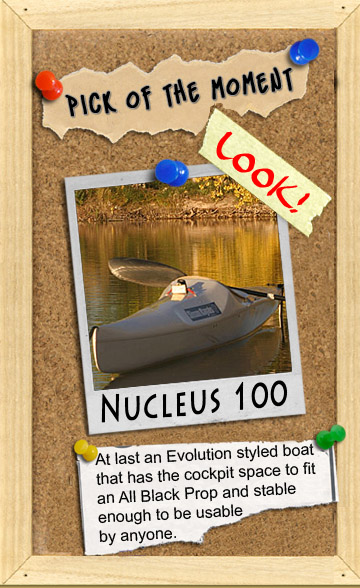-
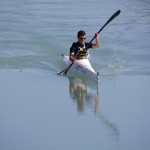
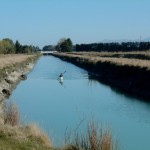
Luke in Omega @ 160HBPM - note the 'riffle' wake waves
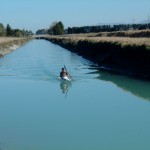
- Luke in his Edge @ 160HBPM – note the rolling wake
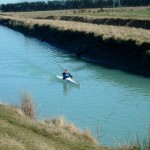
Basil in his Edge - note rolling wake against bank
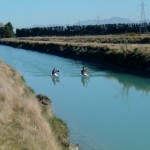
Luke in Edge = Basil running even. Luke in Omega = Basil out-the-back
Basil is in the Omega on the left and Luke is in his Edge on the right. Compare the wakes.
These photos were taken on a 700 metre straight on the Rangitata Diversion Race (RDR), just 10 metres from where these kayaks were manufactured. Weather clear and calm. Of special interest, Luke Vaughan considers our RDR, which is deep and suffers zero bottom drag, the best testing water close to Christchurch.
Luke did all of this testing at 160HBPM. He returned at a later date to do another set of testing at 130HBPM. The results were still the same – Omega has ‘greater-distance-made-good-for-lower-fuel-burn’. Or put another way – faster.
There are more (and better) Omega images coming. I am still mastering this photo upload thing – and I will put up more photos when I have the technique sorted.
Click on the images above to enlarge them
A kayak paddled at aerobic intensity (true multisport race endurance level) is purely a displacement vessel. At this displacement speed two types of drag are coming into play.
- Surface-drag – which can be minimized by careful hull design – minimizing the ‘wetted’ area. Multisport Barges (Dave Hunter’s name – I love it) all suffer from massive surface drag.
- Wave-making-drag – which is the ultimate drag that stops top endurance athletes going faster – they just start digging-a-hole in the water. The bow comes up – and the stern sinks. Massive power increase will make this vessel go into semi-displacement mode – but most endurance athletes will only hold this high output for very short (30 seconds) periods.
Every Sisson Kayaks multisport kayak model is designed to minimize the wetted area. Sisson Kayaks has done our best to help you maximize your distance-made-good-for-lower-fuel-burn. Some designs from other pens induce me to LOL.
The images above clearly show the Evolution Edge to be generating a 160HBPM bow-wave that is starting to sap the will of Luke.
The Omega images (more uploaded soon) clearly show that the 160HBPM is producing even-greater-distance-made-good with not much wave-making drag. The surface drag remains as the one to prevail against. So the aerobic performance is already enhanced. But who knows what will happen if that same paddler wants some more by going anaerobic for a short time? I do know the answer to that question. And so does every shipping company in the world since 1970!
Please tell me this. I have wanted to ask is question for many years. Why do Auckland multisporters test their multisport kayaks for ‘speed’ – by doing 500 metre anaerobic sprints through Westhaven Marina? Lots and lots of laughs from me. I can solidly state – I have forgotten more about boats than such ‘experts’ ever knew.
Disclosure
1947 – built my first boat – out of a clay sealed black-current-picking-tray. It sank.
1953 -1960 – rafted many of the rivers around Hanmer on truck tubes
1960’s – owned a fast ski boat and enjoyed many fast and rough waterski marathons
1966 – First kayak river trip down the Wairau River – in flood.
1967 – 1971 – many Fastest-boat-of-the-day certificates at so many NI speedboat races.
1969 – NZ 75 cubic inch Hydroplane Outright Champion
1975 – built my first kayak – just because I wanted one myself.
1976 – Designed the 2.4 metre compact Gap One kayak. Anne Dwyer ran the Colorado River in one and then set out to change the world of kayaking. The original short river kayak.
1977 – Imported the Nordkapp mould from the UK. Thus starting in NZ the real sport of sea kayaking
1978 – Started production (200 sold) of the Nelson Lugger – still to this day the fastest volume-production rowing dinghy in New Zealand history. Challenge me on that claim.
1987 – Invented the new multisport kayak class – The Triathlete – a ‘river’ boat fitted with a rudder.
1989 – co-invented the winning-est multisport kayak ever – the Evolution
1989 – being the first Speights Coast to Coast sponsor to do the event. I wombled down the river in my Delaware kayak and did the final cycle just 3 minutes slower than Doug Lomax – who won the event. Strangely I blame my great kayak for this great cycle feat. I was an untrained ‘slob’ – athletic-wise. But I had a well planned race strategy.
1996 – Became the accidental owner of a Rinker 180 speed boat – Lynda had taken me shopping for a coffee table – I still greatly enjoy using that piece-of-160HP-lounge-furniture!
1997 – re-started Sisson Kayaks as a one-man-band ‘hobby’ business. Inventiveness continuously directed to mechanizing the kayak factory. Still happening.
2010 – Favourite boating – sailing our (overpowered with the gunnel under the water) Nelson Lugger. And paddling my Voyager and Omega on the Grove arm of Queen Charlotte Sound.
 Cart: 0 item(s)
Cart: 0 item(s)